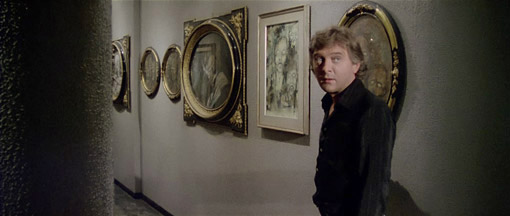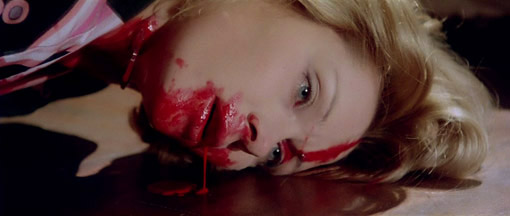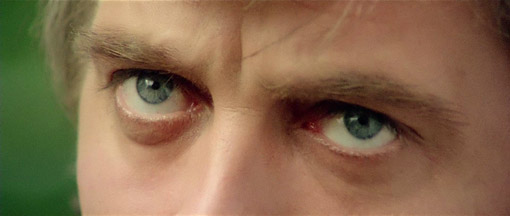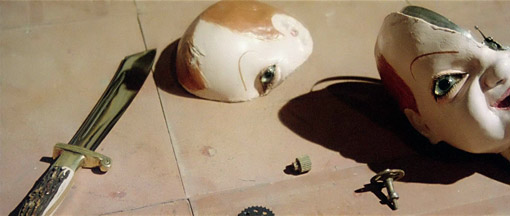|
Here's an idea. Start a conversation with horror fans about giallo cinema and see how much time passes before one or all of them start talking about Dario Argento. I'm guessing less than a minute. Argento towers over this very Italian subgenre, a position of authority he inherited from his mentor and genre godfather Mario Bava. It's fair to say that the film that really brought Argento international attention with the 1977 Suspiria, which as far as I can recall was the first 70s giallo film to get a major UK cinema release. In my neck of the woods it was screened at the same cinema where the big Hollywood movies like Superman played, and it left us eager young horror fans reeling. We'd genuinely never seen or heard anything like it, and it remains one of the most extraordinary audio-visual experiences I've ever had in a cinema.
But if you're talking to genuine giallo fans, then the conversation won't settle on Suspiria for long and will soon move onto the other two films in Argento's Three Mothers trilogy (the 1980 Inferno and the 2007 Mother of Tears), the visually startling 1987 Opera, and his arresting debut feature, The Bird With the Crystal Plumage. But the film that's pretty much guaranteed to become the subject of enthusiastic discussion is the one Argento directed and co-wrote immediately before Suspiria, the 1975 Profondo rosso, or as it was known on foreign shores, Deep Red. And if you've never managed to catch it then buckle yourself in, because it's an absolute belter.

As the credits unfold, a murder is committed, witnessed only in shadow to the creepily off-key la-la-la of a child-sung nursery tune, following which a bloodied knife drops to the floor. Who killed who? You'll have to wait. We're then introduced to celebrated German telepath Helga Ullman, who is demonstrating her skills to a rather small audience in a very big theatre when she picks up the vibe of a violent murder committed by someone in the audience. At the conclusion of her performance she tells her friends Professor Giordani and Mario Bardi that as soon as she gets home she plans to write down everything she saw in her vision, and assures them that she would be able to identify the killer. Oops. As genre fans will know, there's one thing you should never do in this situation, and that's tell someone that you know who the killer is and then bid them goodnight, particularly when you're being watched by an unseen figure. No surprise, then, that Helga is visited that very evening by the subject of her vision, who busts in to her apartment and starts swinging a machete.
At that very moment in the spookily quiet town square below, London-born jazz pianist Marc is chatting with hopelessly drunk fellow musician Carlo when a scream rings out. Carlo, ever the charmer, wonders if it's someone being raped and drinks a toast to the victim, then stumbles away, leaving Marc to witness Helga's head being shoved through her apartment window. A short while later he's being questioned by the cops when in pops bubbly young female reporter Gianna Brezzi, with an instamatic camera incapable of capturing the clear image of Marc that ends up plastered over next day's front page. Marc, meanwhile, can't shake off the feeling that one of the paintings he saw when he first entered the apartment has been removed or somehow changed. With the police about as much use as they usually are in giallo cinema, Marc teams up with Giordani and (eventually) Gianna in an attempt to solve the crime, but the killer always appears to be one step ahead.
Suspiria was one of those rare films whose surplus of style really did compensate for its lack of substance. Visually Deep Red is every bit its equal, from Armando Mannini's eye-popping production design to Luigi Kuveiller's immaculate scope compositions, prowling camera moves and macro-photography. But in story terms, Deep Red has a real edge on its thinly plotted successor, boasting enough ingenious and inventively staged twists to comfortably carry the film through a couple of inevitabilities (the very moment the trail leads to one Amanda Righetti, we just know she's for the chop) and provide real substance between the set-pieces.

The killings are as violent as the genre commands, with the gore kept in check by Argento regular Franco Fraticelli's needle-sharp editing, though Germano Natali and Carlo Rambaldi's make-up effects are convincing enough to make an impression on the briefest of glimpses and to survive scrutiny when dwelled on. The murders themselves are genuine show-stoppers of macabre creativity, as much for the tension and surrealism of the build-ups as for the nastiness of the acts themselves, with one victim terrorised by her own mynah birds before being drowned in scalding water, while another is approached by what may be the creepiest mechanical mannequin I've ever laid eyes on before having his teeth smashed against a marble mantelpiece and his head pinned to the floorboards with a very large knife. So effective are these wind-ups that they work even when logic dictates there'll be no pay-off, as when Marc is menaced in his own apartment less than halfway through a film in which he's been clearly established as the lead character.
Sonically it's on sometimes shakier ground. This was the first Argento film scored by Italian rock group Goblin, and the results vary considerably from the sort of creepy atmospheric electronic sighs that prefigure the group's stunning work on Suspiria and a main theme that was a direct influence on the one for Halloween, to some teeth-grindingly unrestrained prog rock in sequences that would frankly have played better in silence. This occasional lack of subtlety is highlighted by Argento's fondness for rapidly fading loud music in and out, like it's suddenly been cut short by censorious scissors. Although hugely influential and a popular stand-alone success, the score also has its own audible borrowings, with the bass guitar riffs that accompany to Marc's first investigation of the Schwartz house ripped almost note-for-note from Mike Oldfield's Tubular Bells.
The dialogue delivery is similarly uneven, a common issue in Argento films with an English or American star, where the lead actors delivered their lines in English and the supporting cast stuck with their native Italian, then everyone was post-dubbed in either Italian for the domestic market or English for export. Thus while the mouths of the main actors match the English dialogue, only leading man David Hemmings appears to be voicing himself, resulting in that ersatz English that 70s Italian exploitation cinema had down to a fine art. Consequently (on the English language version at least) it's Hemmings who runs away with the acting honours, though Glauco Mauri's well judged turn as Professor Giordani survives the redub better than expected, and actress Geraldine Hooper impressively (and convincingly) underplays the role of Carlo's effeminate male lover Ricci.

This post-dubbing artificiality is, of course, par for the giallo course, and while this may prove a barrier for genre newcomers, it's one they'd do well to live with, as in all other respects respects Deep Red is probably Argento's most fully realised and seductively structured film to date, and a spectacular bounce back to form after the non-genre misstep that was Five Days in Milan [Le cinque giornate]. A harmonious balance is struck between story, character and set-piece violence, and the film even flirts successfully with character comedy (the sudden drop of the passenger seat in Gianna's car is a hoot) and throws in a small shout for female independence in the face of Marc's clunky sexism ("Oh, don't start with me about all that woman's stuff!"). Tense, startling and enthrallingly told, it's a stylistic tour-de-force that remains one of the great works of Italian giallo and justifies its status a classic of 70s horror cinema.
Both the international theatrical cut and the director's cut have been included here, and although the latter is twenty minutes longer, structurally they are very similar films. Much of the additional material consists of conversations between Marc and Gianna, which helps to flesh out their relationship and clear up a couple of plot points. A phone call made by Marc that is drowned out by traffic noise amusingly echoes an earlier café scene, and is preceded by further evidence that giallo police are possibly the biggest buffoons on the planet. Perhaps the nicest inclusion shows Marc and Carlo playing piano together in a bar, a single, dialogue-free shot that somehow says more about their friendship than all of their other encounters combined.
A film as visually arresting as Deep Red has, since its first arrival on home video, been crying out for the sort of transfer it gets here. Although a few dust spots remain, the picture is for the most part very clean and the crispness of detail easily outstrips any previous video or DVD release, something that really registers in the busier wide shots and facial close-ups, where sweat, tears and even skin texture are clearly defined. Flesh tones sometimes have an unnaturally green hue, but those all-important reds are vividly captured, notably the curtain backdrop to Helga's performance and, of course, the blood. The contrast varies somewhat, suggesting that more than one source was used for the restoration – sometimes it's well balanced, while at others the detail in darker areas has been sucked into a swathe of deep black. But despite these inconsistencies, this is still a pleasure to watch and showcases Luigi Kuveiller's lovely scope cinematography well. There is a brief digital picture glitch just over 45 minutes (by director's cut timing), but its appearance is fleeting.

There's a welcome choice between the English Language and Italian soundtracks, with optional subtitles provided for the latter. Both are available in their original Dolby stereo 2.0 and both show their age, though the English track definitely comes off worst, having a restricted range, a treble bias to the dialogue, an audible background hum, and some occasional shifts in volume. The Italian version fares better, and on the director's cut it's also available as a remixed DTS-HD Master Audio 5.1 track, and sonically this leaves its companions coughing in the dust, particularly in the fabulous clarity, range and punch of Goblin's score. Much (if not all) of the English dialogue in the director's cut has been lost or was simply never recorded, and the audio on these sequences switches from English to automatically subtitled Italian, which is, of course, delivered by different actors.
Most of the extras accompany the director's cut on disc 1.
Commentary
Danish Argento expert Thomas Rostock delivers one of those commentaries that describes the on-screen action and camera moves in the sort of detail that assumes you're not actually watching the film while you're listening, and the sense that you're attending a university film studies lecture is really brought home when he says things like, "I want you to take note of this image..." and suchlike. Righty-ho, sir. Fortunately there is some analytical expansion and some usually interesting background to the production, plus a brief rundown of Argento's career and the giallo genre.
US Theatrical Trailer (2:47)
A well edited sell bounced along by the sort of gravely toned voice-over I tend to associate with trailers for movies that ended up on the video nasties list. Includes warnings like, "Deep Red – it will put you into deep shock." The sparkly picture quality suggests this has been reconstructed from the restored transfer.
Italian Theatrical Trailer (1:52)
An altogether stranger and frankly more seductive trailer constructed short clips, strange noises and stills and makes it look like the film was directed by David Lynch in the run up to Eraserhead.
Lady in Red – Daria Nicolodi Remembers Profondo Rosso (20:39)
Lead actress Nicolodi recalls shaping and playing the role of Gianna Brezzi and how she first met our Dario, with whom she had a long term relationship and a daughter whose fan-boy following almost rivals that of her father. She also provides a brief insight into the influence of specific painters – Edward Hopper included – on the look of the film, and tells a couple of interesting stories about working with David Hemmings, but perhaps most revealing is her description of Argento as "egocentric, narcissistic and a total hypochondriac." Like all of those interviewed, she's asked about the rumour of a 3D retooling of the film, and responds that just everyone has told Argento not to do it.
Music to Murder For – Claudio Simonetti on Deep Red (15:26)
Goblin composer and keyboardist Simonetti (who also introduces the film) recalls how the band came to meet Argento and compose the score, something the then young musicians were initially overwhelmed by. Initial expectations that this was a one-off gig were overturned when the album went on to become one of the biggest selling horror movie soundtracks of all time, spending fifteen weeks at number 1 and over a year in the charts. Simonetti also takes a dim view of the prospect of a 3D remake.
Rosso Recollections – Dario Argento's Deep Genius (13:59)
A suck-up title for an always welcome interview with Argento himself, who looks a little shell-shocked but provides some choice info on his past approach to character, his own childhood experiences prompting his belief that family was the worst aspect of a person. He tells an engaging tale about how he first encountered the cut version of Deep Red film in a Martinique bar, and dismisses the suggestion of a 3D version as just a rumour, expressing a dislike of remakes, something I think we can all share.
The final video extra is on disc 2.
Rosso From Celluloid to Shop (14:46)
Luigi Cozzi, co-writer of Argento's 1971 Four Flies on Grey Velvet (4 mosche di velluto grigio) and director of some really cheesy Italian fantasy films such as the Starcrash (1978) and the Hercules (1983), introduces us to Argento's fantasy film shop Profondo Rosso, which he now runs and which came into being because of Argento's fondness for London's Forbidden Planet and his desire to set up something similar in Rome. We also get a brief tour of the shop's movie museum and extracts from the films the collected props were used in.
Also included is a small Booklet, containing an enthusiastic piece on the film by Alan Jones, and a double-sided fold-out Poster. As ever, there's the option to select from four different DVD covers. I'm a big fan of this packaging.
For many Deep Red is the finest film in the distinguished horror career of one of the genre's acknowledged masters, and it's easy to see why. It boasts some of Argento's most darkly inventive set-pieces, one of his best leading men, and what has to rank as his most satisfying and well structured storyline. The picture quality on Arrow's 2-disc Blu-ray may not be perfect, but it's still leagues ahead of previous DVD releases and is backed by an excellent Italian DTS sound mix and some enjoyable extra features. For horror fans especially, an absolute must-have.
|